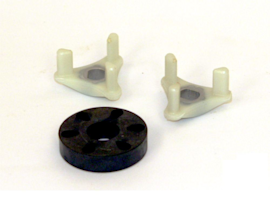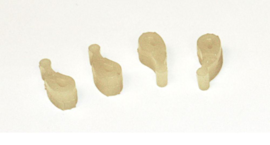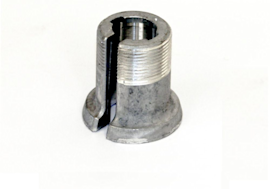Troubleshooting a top-load washer that won't drain or spin video


This video from Sears PartsDirect shows what to do if your top-load washer won’t drain water or spin, including how to check hoses and drain lines for clogs and how to check the drain pump for debris.
If you don't find a clog, a part could be malfunctioning:
On an older direct-drive model, the problem could be the timer or the lid switch.
On a washer with a vertical modular drive system, the shifter could be broken. A vertical modular washer (VMW) is a Whirlpool or Kenmore washing machine made in 2010 or later that has has a control dial for setting the wash load and stays locked whenever the washer is running.
We explain how to tell which kind of washer you have and walk you through correctly diagnosing the problem and fixing it.
Tools and parts needed
Bucket
Plumber's snake
Shop vacuum
Wrench
Screwdriver
Vegetable oil
Insulated jumper wire
Work gloves
Check for clogs in the drain hose and drain pipe
Hi, this is Wayne with Sears Parts Direct. Today we're going to talk about what to do when your washer won't spin or drain water.
First, let’s confirm that your washer’s not draining. Set the washer in the spin mode and see what happens. If the water won't drain, turn the machine off, pull the drain hose out of the standpipe and check for a clog at the end of the hose. Sometimes lint or debris can build up in this area and prevent draining. Then, lower the drain hose into a bucket close to the floor and see if the water drains out of the tub using nothing more than gravity.
If water flows freely, then check your house drain for a clog. Get out that plumber's snake and try clearing your house drain pipe. If you didn’t see any water coming out of the drain hose, then we’ll check the washer's drain system. Try using a shop vac to suck the clog and the water out of the washer. If that doesn’t work, you’ll need to bail some water out through the top of the washer and use a shop vac to suck out the rest from the tub. Once you get the water out, unplug the washer, disconnect the drain hose from the back and check it for a clog.
If the drain hose is clear, turn off the water valves and disconnect the fill hoses from the back of the washer. Then, you can tilt your washer over and check your drain pump. Baby socks and other small items can work their way down there. Disconnect the hose and look for small items or debris. Remove the screws, pull the drain pump off, and check the area between the pump and the tub for obstruction.
Check the drain pump
Now, if you didn’t find a clog and the water drained into the bucket using gravity, chances are you’ve got a bad drain pump. If your drain pump is malfunctioning, it won’t push the water out during the normal drain cycle. If the pump runs but won't move water, replace the pump. This video will show you how.
Defective shifter or too many suds
Now we'll cover some tips for two common types of top-load washers made by Kenmore, Whirlpool and Maytag. If you bought one of these washers after 2010 and it has a lid lock light, then you likely have a VMW washer. If your model is pre-2010, chances are you have a direct-drive washer.
First, we’ll talk about the vertical modular washers. The nice thing about a VMW is that when it runs into a problem, it’ll trigger an error code. The error code points you in the direction of which part has failed. To learn how to check error codes for VMW washers, take a look at this video.
Once you have your error code, you’ll probably have a better idea of what’s going on. If your washer isn’t draining, you might see error code F7E5. This code indicates that you have a broken shifter, the part that sends the washer into the spin and drain modes (also called an actuator). If your shifter needs replacing, here's a video that will walk you through that process.
Another code you could run into when your washer isn’t spinning is F0E2, which tells you that your washer is oversudsing. Obviously, this condition is a bit easier to spot than a broken shifter. If your washer is full of suds, it can actually prevent it from draining properly. To get rid of suds, you can add a 1/4 cup of vegetable oil to the water in the tub, then run a drain and spin cycle. Remember to use less soap next time. You really only need about a tablespoon of detergent for loads in HE washers.
Check the timer
Next, we’ll talk about some issues that pop up with direct-drive washers. The direct-drive washer uses a neutral drain process, which runs the drain pump to drain all the water out before the basket starts spinning. The basket won’t spin while the washer is draining. When the washer is working correctly, you'll notice the motor pauses after draining all the water. When the motor restarts, the basket spins.
Sometimes, direct drives can get stuck in the neutral drain process. The tub drains and you can hear the motor running, but the washer won’t enter the spin mode. You'll need to replace the timer to correct this condition because the timer controls the motor pause.
Before you buy a timer though, let’s make sure it’s really broken. Start a new wash cycle and allow the washer to fill and agitate for several minutes. This will reset the drive system to conduct the neutral drain process. Move the timer to the start of the spin cycle and pull the start knob. Don’t open the lid. You will hear the motor running, but the washer won’t be spinning. If the washer pauses after several minutes then begins to spin the basket, then your timer is probably okay. If the washer continues to drain until the end of the cycle, but never spins the basket, then you'll need to replace the timer. Here’s a video that will show you how.
Here’s a trick so you can keep using your washer till you get a new timer. You can manually pause the motor and end the neutral drain process by lifting the washer lid for a few seconds after the washer is empty while the motor is stuck in the draining position. Once you close the lid, the basket should start spinning. You can keep tricking your washer like this until you get around to fixing it.
Test the lid switch
Now, if the motor never runs in the spin mode but does run in the agitation mode, then you could have a bad lid switch. This washer won’t spin, with the lid open, to prevent injuries. If the lid switch is broken, it will keep the motor from running in the drain and spin mode.
Here's how to test the lid switch: Unplug the washer, for safety. Remove the console end caps, then remove the hidden screws from the console base. Pull the console slightly forward then flip it up and back to access the lid switch wire harness plug. Unplug the wire harness and place an insulated piece of wire in the lid switch harness to connect the gray and tan wires going to the timer. Cover the plug with electrical tape so there's no chance of the jumper wire shorting to the metal cabinet. This bypasses the lid switch so the washer thinks that the lid is closed. Tuck the bypassed harness out the way and reassemble the console. Plug the washer back in. Set the washer in the spin cycle and see if the motor runs. Don't lift the lid with the motor running. The spinning basket inside moves fast enough to cause serious injury. The motor won't stop if you lift the lid with the switch bypassed.
If the motor runs with the lid switch bypassed, you’ve confirmed that the lid switch is broken and will need to be replaced. Here’s a video that will show you how. Immediately following this test, unplug the washer and restore the lid switch to its original condition by opening the console and removing the insulated jumper wire. Plug the lid switch wire harness back in. Don't leave the lid switch bypassed! If the motor won’t run with the lid switch bypassed, you could have a defective timer or you could have a motor wiring problem. You probably want to get a service technician to check that out for you.
Hey thanks for watching. Be sure to check out our other videos here on the Sears PartsDirect YouTube channel. Subscribe and we'll let you know when we post new videos.
Repair guides for top-load washers

How to replace the motor coupler on a top-load washer
If the washer drains but won’t agitate or spin, the motor coupler might have broken to protect the drive motor from dama…

How to replace the agitator dogs in a top-load washer
If the top of the agitator moves both ways instead of just one, replace the agitator dogs, using the steps in this repai…

How to replace the drive block on a top-load washer
The drive block rotates the spin basket. If the basket wobbles or rattles in the spin mode because the drive block is wo…
Articles and videos for top-load washers

Find tips for using your washing machine efficiently to save energy and help reduce utility bills.…

Learn about all the convenient features on our Sears PartsDirect website that make your parts purchases easier.…

Get answers to frequently asked questions about Sears and Sears PartsDirect.…